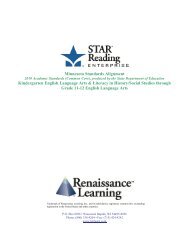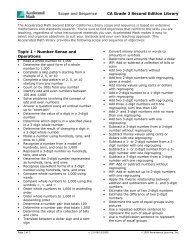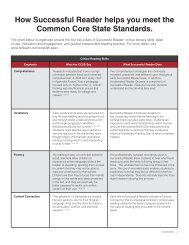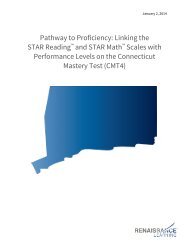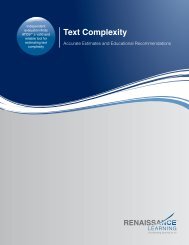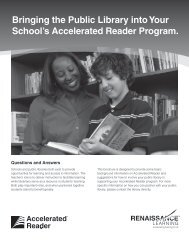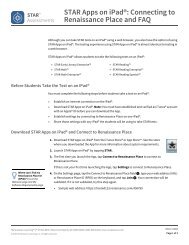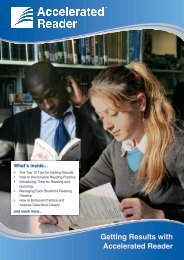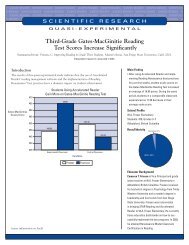Technical Manual - Renaissance Learning
Technical Manual - Renaissance Learning
Technical Manual - Renaissance Learning
Create successful ePaper yourself
Turn your PDF publications into a flip-book with our unique Google optimized e-Paper software.
Content and Item DevelopmentItem Development: STAR Early Literacy Enterpriseprototype and of the tryout items in classrooms ranging from pre-kindergartenthrough grade 2.The user interface proved to be usable at all levels. The tasks were well within theability of children to complete in a minimum of time. The tryout test itemsdemonstrated promising psychometric properties. And teachers generally reactedwell to the content and format of the prototype. Weak points that were found inthe analysis of the tryout study data were corrected in the revised versions of thesoftware used in subsequent studies. (Most weak points were related tocorrectable audio problems.)With the blueprint as a guide, items were then written and designed to target theminimum grade level and up for each domain and skill set. For example, an itemwritten at the kindergarten level might include named pictures as answer choices.The same item might then be targeted at the first grade level by using namedwords as answer choices, and at the second grade level by using unnamed wordsas answer choices. A total of 2,991 test items were written, spanning the sevendomains and 41 skill sets.Once the test design was determined, individual test items were assembled fortryout and calibration. The item calibration included a total of 2,929 items. It wasnecessary to write and test about 1,000 questions at each of three grade levels(kindergarten through grade 2) to ensure that at least 600 items per level would beacceptable for the final item collection. Having a pool of almost 3,000 itemsallowed significant flexibility in selecting only the best items from each domainand skill set for the final product.Item Development: STAR Early Literacy EnterpriseBalanced Items: Bias and FairnessItem development meets established demographic and contextual goals that aremonitored during development to ensure the item bank is demographically andcontextually balanced. Goals are established and tracked in the following areas:use of fiction and nonfiction text, subject and topic areas, geographic region,gender, ethnicity, occupation, age, and disability.Items are free of stereotyping, representing different groups of people innon-stereotypical settings.Items do not refer to inappropriate content that includes, but is not limited tocontent that presents stereotypes based on ethnicity, gender, culture,economic class, or religion.Items do not present any ethnicity, gender, culture, economic class, orreligion unfavorably.STAR Early Literacy<strong>Technical</strong> <strong>Manual</strong>28





